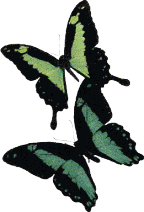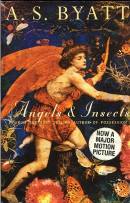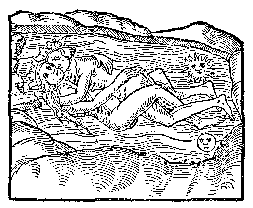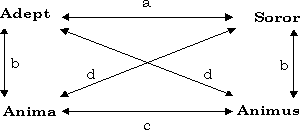
Mary Lynn Richardson
Part II of a two-part essay on Jungian paradigms in A.S. Byatt's novella "Morpho Eugenia," (published in Angels & Insects, Vintage Press, 1992), and filmed by Philip Haas in 1995 as Angels and Insects.

A.S. Byatt. Angels & Insects: Two Novellas. London: Vintage. 1992.
 At the core of A.S.
Byatt's 1992 novella, "Morpho Eugenia" --and the film Angels and Insects
based upon it--lies a shameful secret: incest. When, at the climactic denouement of the
story, Eugenia Alabaster is discovered in flagrante delecto with her brother
Edgar, the pieces of the story's puzzle fall into place. There is horror, certainly. And
revulsion. But for Eugenia's husband, William Adamson, there is principally a sense of
freedom. He may return now to his life's work as a naturalist of the Amazonian jungles;
with him goes Matty Crompton, the femme inspiratrice who engineered the means of
his financial independence from the Alabasters with consummate skill. Matty, as woman, may
finally be seen.
At the core of A.S.
Byatt's 1992 novella, "Morpho Eugenia" --and the film Angels and Insects
based upon it--lies a shameful secret: incest. When, at the climactic denouement of the
story, Eugenia Alabaster is discovered in flagrante delecto with her brother
Edgar, the pieces of the story's puzzle fall into place. There is horror, certainly. And
revulsion. But for Eugenia's husband, William Adamson, there is principally a sense of
freedom. He may return now to his life's work as a naturalist of the Amazonian jungles;
with him goes Matty Crompton, the femme inspiratrice who engineered the means of
his financial independence from the Alabasters with consummate skill. Matty, as woman, may
finally be seen. The revealing of the shameful secret in "Morpho Eugenia"--with its concomitant sense of release from a complex situation which held the players in its thrall--is, in analytical terms, "the resolution of a transference." In the paradigm central to understanding the analytic relationship in Jungian practice, the "marriage quaternio," and particularly in Jung's illumination of this encounter through the alchemical pictures of the Rosarium philosophorum (1), we find the pattern of relationships so vividly wrought in Byatt's story mirrored with uncanny exactitude.
Not that Byatt intended this. She set out to write an elaborate metaphor between an ant heap and a Victorian mansion, and to examine questions of power and slavery. The incest at the core of the story occurred to her only very late in the writing, when it seemed a necessary development of the original metaphor. This makes the alchemical marriage quaternio in "Morpho Eugenia" all the more intriguing.
Jung described the marriage quaternio of analytical transference in 1954, and illustrated it with the now familiar diagram showing the complex flows of energy between a man (Adept), a woman (his "sister" or Soror), the Adept's unconscious female side (Anima) and the Soror's unconscious male side (Animus). An incestuous flavour to the quaternio is implied in the term "Soror".

Because analytical relationships are exogamous there is a tendency to ignore or repudiate Freud's original discoveries of the incestuous nature of analytical transference. But Jung observed, "this gets us nowhere, for we are dealing with an empirically demonstrable fact which meets with such universal confirmation that only the ignorant still try to oppose it." (1954:¶368) Indeed he had not far to look: in his first analysis with the young medical student, Sabina Spielrein, the theme of incest manifested through their identification with Brünnhilde and Siegfried, whose brother-sister incest provides an emotional high in Wagner's Ring cycle. (2) "The existence of the incest element involves not only an intellectual difficulty," Jung later wrote, "but worst of all, an emotional complication of the therapeutic situation. It is the hiding place for all the most secret, painful, intense, delicate, shamefaced, timorous, grotesque, unmoral, and at the same time the most sacred feelings which go to make up the indescribable and inexplicable wealth of human relationships and give them their compelling power." (1954:¶371).
But why incest, with all its implications?
The answer, Jung argues, is that the incestuous aspect of the relationship takes place in the unconscious union of Animus and Anima, who carry the symbolic weight of the Sun and the Moon with the archetypal incestuous energies of the twins Apollo and Artemis. At bottom the incest is a symbolic expression of union with oneself.
Here the
mirroring of a marriage quaternio in "Morpho Eugenia"--and particularly in the
visual feast of Angels and Insects--is importantly illustrative. Eugenia, whose
name means "beautiful," carries all the trappings of a personified Anima, not
least in her identification with the (male) butterfly, Morpho eugenia--in Greek ![]() , Psyche or Soul. Her brother Edgar, whose name means both
"prosperity" and "happiness," clearly shares characteristics with
Hades, not only as a personification, but as a place of shadows. Together, in their
astoundingly fertile incestual union, (two sets of twins and a set of triplets, pure
Alabasters all, are born in rapid succession), they echo Jung's description of the
incestuous element in a transference in every detail. Moreover, like Anima and Animus,
they are "insiders" in the Alabaster household, while William and Matty are
"outsiders."
, Psyche or Soul. Her brother Edgar, whose name means both
"prosperity" and "happiness," clearly shares characteristics with
Hades, not only as a personification, but as a place of shadows. Together, in their
astoundingly fertile incestual union, (two sets of twins and a set of triplets, pure
Alabasters all, are born in rapid succession), they echo Jung's description of the
incestuous element in a transference in every detail. Moreover, like Anima and Animus,
they are "insiders" in the Alabaster household, while William and Matty are
"outsiders."
But no attempts to understand a marriage quaternio are that simple. Byatt, in being true to her story, shows this well, as does the film. As the film ends, William and Matty, as physically alike as two peas in a pod, sit side by side in the small vas of a carriage which is to take them to the dark interior of the other/under world. They could be the twins Osiris and Isis in the womb. A little smile plays on the lips of Matty, as though she knows the divine sun child, Horus, is now conceived.
"Analogy is a slippery tool," says Byatt's William. "Men are not ants." Nor gods. And yet . . . . .
1 See Jung, C.G. Psychology of the Transference (CW 16). Princeton. 1954, 1966. Return.
2 See Kerr, John. A Most Dangerous Method. New York: Vintage. 1993. Return
*First published by Society News of the C.G. Jung Society of Calgary in Alberta 6(1):4 1997.

